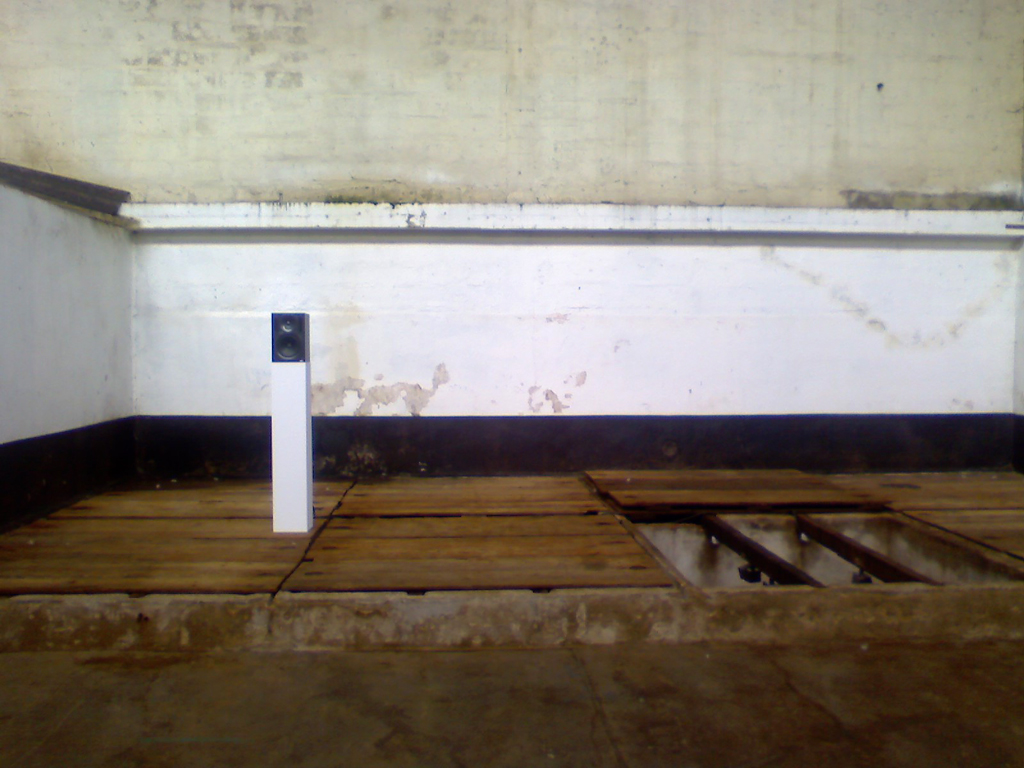Quant-à-soi
sound installation with 2 speakers
2002
exhibition Chambres sourdes, Domaine de Rentilly, Bussy-Saint-Martin, 2011 (cur. Audrey Illouz)
exhibition The mer, Site Capécure, Boulogne-sur-Mer, 2007 (cur. Amélie Codugnella)
Festival Archipel, Salle du Plain-Palais, Genève, 2002 (cur. Marie Jeanson)
Quant-à-soi (Aloofness) – version with English subtitles
exhibition gb agency at Croy Nielsen Gallery, Berlin, 2009
Quant-à-soi (Terughoudend) – bilingual version French/Dutch
exhibition Vollevox, Komplot, Musées Royaux des Beaux-Arts de Belgique, Brussels, 2004
Quant-à-soi (-) – bilingual version French/ThaÏ
exhibition Here and Now, AARA Foundation, About Café, Bangkok, 2004 (cur. Nathalie Boutin)
dddd
The installation called Quant-à-soi connects two voices and two acoustic perspectives: one close and one distant.
In a first space, a speaker emits a woman’s voice. It is mounted on a pedestal, to be seen somewhere. It has the status of what is close. The voice talks about the invisible links that relate it to the others. Long silences between the sentences make way to the second voice. In a second space that the visitors cannot see, on the other side of a wall, a second speaker emits the voice of a man who yells in the distance; he rants and talks in an unintelligible manner. It has the status of what is distant and seems to come from a highly reverberating space.
The editing structures the non direct, invisible links between the two voices. A sung passage makes this agreement manifest.

excerpt 1
extrait
hiuhuu
hiuhuu



–
Domaine de Rentilly, Bussy-Saint-Martin, 2011 – photos Aurélien Mole
gggg



Site Capécure, Boulogne-sur-Mer, 2007 – photos D.P.

This version takes up the whole space of an empty theatre (off performance and rehearsal times).
The first voice, that of the woman, is located upstairs on the dress circle right in the middle of a row of seats. This is the only place where the visitors can go to hear this voice at close range. The second voice, that of the man (unintelligible yelling haranguer), is hidden out on the stage inside the prompt box and can be heard from afar, resounding all over the reverberating space.



Salle du Plain-Palais, Genève, 2002 – photos D.P.
version with subtitles
Quant-à-soi (Aloofness).
In this version with subtitles, the sound stays the same (voices in French). In an intermediate space, step of the way from the first voice to the second and hidden one, a screen set on the wall shows the written and synchronous translation. English translation by Miles Hankin.






Croy Nielsen Gallery, Berlin, 2009 – photos D.P.
ggggg
bilingual version French/Dutch
Quant-à-soi (Terughoudend).
In this bilingual version, the French voice is accompanied by a second one, the voice of a female translator who repeats and automatically translates in reported speech into the other language of the hosting country (Dutch).
The translator’s voice has been recorded on a phone. The recording background noise allows to hear the distance between the two languages and distinguishes the two voices.
This version is located inside a large lift with seats which connects the different floors of a museum. This space is a rest area, a break in the visits of the rooms. Its status is almost that of a public space. To the sounds produced by the lift machinery itself are added other sounds: rumors, vibrations, unspecified underground layers, all of them making music out of this whole and making the listener have doubts as to the origin of all he perceives. The duration of the silences endows the piece with a discreet, disruptive and unsettling presence.
Oral translation in Dutch by Sophie Nys.

excerpt 2 bilingual version French/Dutch
ggg
ggg
ggg






Musées Royaux des Beaux-Arts de Belgique, Brusels, 2004 – photos D.P.
bilingual version bilingue French/Thaï with headphones
Quant-à-soi (-).
In this bilingual version for which the female translator’s voice has been recorded on the phone, can be heard with headsets lent on request to the visitor so he may walk along the street that connects, outdoors, the different stages of the exhibition.
The headphones that are used are called “open”. Unlike “closed” headsets which do not allow anything else but what is recorded to be heard, “open” headsets allow to hear the surrounding noises. Therefore, the listener has a private access to the mixing between inner sounds and outer ones.
The two voices (in French and in Thai) alternately overlap according to a dotted pattern, like some mental commentary on the street events and activities.
Oral translation in Thaï by Tatsanai Wongpisethkul.

excerpt 3 bilingual version French/ThaÏ
ggggg
ggggg
ggggg


AARA Foundation, About Café, Bangkok, 2004 – photos D.P.ddd